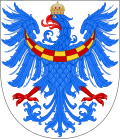| Coat of arms of Slovenia | |
|---|---|
 | |
| Armiger | Republic of Slovenia |
| Adopted | 1991 |
| Shield | Azure, a mountain of three peaks Argent, base barry wavy Argent Azure, in center chief three mullets of 6 Or lower, bordure Gules. |
The coat of arms of Slovenia is an emblem [1] that consists of a red bordered blue shield on which there is a stylised white Mount Triglav, under which there are two wavy lines representing the sea and the rivers of the country. Above Mount Triglav, there are three golden six-pointed stars representing the Counts of Celje. [2] It was designed in 1991 by Marko Pogačnik and adopted on 24 June 1991.












